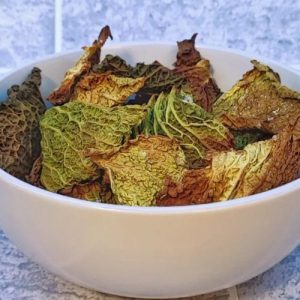
Crispy Cabbage Chip
Transform simple cabbage leaves into crunchy, savory chips that are low in calories and carbs, fiber-rich, and quick to make. Perfect for snacking, appetizer plates, or a healthy addition to your meal prep.
Equipment
- 1 baking tray
- Parchment Paper (Optional, 1 sheet)
- Oven
Ingredients
- 2 –3 leaves savoy cabbage
- ½ tsp salt or to taste
- Optional: additional seasonings like paprika garlic powder, or nutritional yeast
Instructions
- Select and Prepare the Cabbage: Start by choosing fresh, vibrant savoy cabbage leaves. Look for leaves that are firm, bright green, and free from blemishes. Remove 2–3 leaves from the main head, and gently rinse them under cold running water to eliminate any dirt or debris. Pat the leaves completely dry using a clean kitchen towel or paper towels—any residual moisture will prevent the chips from becoming crispy.
- Remove the Stalk and Rip the Leaves: Lay the cabbage leaves flat on a cutting board. Carefully cut away the thick central stalk using a sharp knife, or gently tear the leaves along the vein to remove it. The remaining leafy parts should be flexible and ready to become chips. If the leaves are large, cut or tear them into smaller, bite-sized pieces—roughly 3–4 inches across—so they bake evenly.
- Season the Leaves: Place the prepared cabbage pieces on a baking tray. Lightly sprinkle ½ teaspoon of salt over the leaves, ensuring an even coating. This not only adds flavor but also helps draw out moisture for better crispiness. For extra flavor, you can experiment with other seasonings such as garlic powder, smoked paprika, chili flakes, or nutritional yeast. Gently toss or pat the seasonings onto the leaves so that every piece has a touch of flavor.
- Arrange Leaves on the Tray: Line a baking tray with parchment paper if desired—this prevents sticking and makes cleanup easier. Spread the cabbage pieces evenly on the tray in a single layer, making sure no leaves overlap. Overlapping pieces will steam rather than crisp, so give each leaf space to allow hot air to circulate freely during baking.
- Preheat the Oven: Preheat your oven to 70°C (160°F). A lower temperature is ideal for slow dehydration, which ensures the chips turn crispy without burning. While waiting for the oven to reach the correct temperature, double-check that the leaves are properly arranged on the tray.
- Bake the Cabbage Leaves: Place the tray in the preheated oven. Bake for 10 minutes initially, then check the leaves carefully. The total baking time can range from 10 to 30 minutes depending on leaf thickness and moisture content. Remove any chips that are already golden and crisp to avoid overcooking. Continue baking the remaining leaves, checking every 5 minutes until all are dry and crunchy.
- Cool the Chips: Once baked, transfer the cabbage chips to a wire rack or plate and allow them to cool for a few minutes. Cooling helps them crisp further as residual heat escapes. Avoid stacking the chips while warm, as this can create steam and reduce their crunch.
- Taste and Adjust Seasoning: Taste a chip to see if the seasoning is sufficient. Sprinkle a tiny extra pinch of salt or your preferred seasoning if needed. Mix gently to avoid breaking the delicate chips.
- Serve and Enjoy: Serve immediately as a healthy snack, appetizer, or crunchy side. These chips are great for pairing with dips, salads, or even as a topping on soups. Their light, airy texture makes them satisfying without being heavy or greasy.
- Optional Storage: If you want to save some for later, store the cooled chips in an airtight container at room temperature. They will remain crisp for a few days if kept away from humidity. Avoid refrigerating, as moisture can make them soft.
Notes
- Use fresh, firm savoy cabbage leaves for the best crunch; older or wilted leaves can produce softer chips.
- Baking at a low temperature is key—too high, and the edges may burn before the leaves dry completely.
- Customize flavorings according to your taste. Garlic powder, smoked paprika, nutritional yeast, or chili flakes work beautifully.
- Keep an eye on the baking process; different leaves may cook at slightly different rates. Remove crispy leaves promptly to prevent overcooking.
- These chips are naturally low in calories, carbs, and fat, making them a healthy, guilt-free snack alternative.